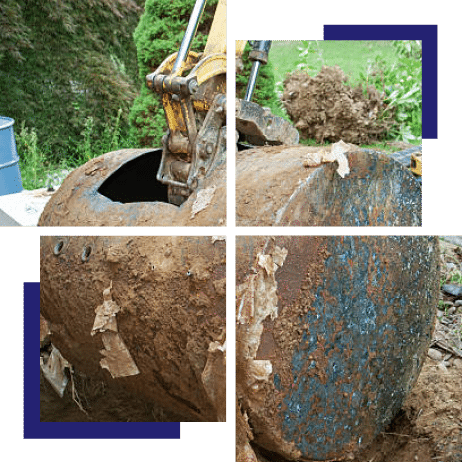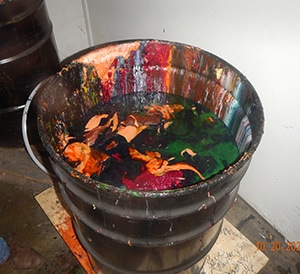Phase I Environmental Site Assessment (ESA) | Portland, OR

What Is a Phase I ESA?
A Phase I Environmental Site Assessment (ESA) in Portland is a comprehensive investigation and evaluation of a property’s environmental history and current conditions completed under the direction of the ASTM Standard (E1527-21). It is typically conducted as part of the due diligence process when purchasing, financing, or developing a piece of real estate, especially for commercial or industrial properties.
The primary goal of a Phase I ESA is to identify potential environmental liabilities (recognized environmental conditions or REC) associated with the property. RECs are conditions that may suggest the presence of contamination or other environmental issues.
What Is Included With a Phase I Environmental Site Assessment?
A Phase I ESA is generally a non-intrusive study, meaning it does not involve drilling, soil or groundwater sampling, or laboratory analysis. If the Phase I ESA identifies potential environmental concerns, a Phase II ESA could be recommended, which involves further investigation through sampling and laboratory analysis.
The primary goal of a Phase I ESA is to identify potential environmental liabilities (recognized environmental conditions or REC) associated with the property. RECs are conditions that may suggest the presence of contamination or other environmental issues.


Key Components and Objectives of a Phase I ESA
Conducting a Phase I ESA in Portland involves a systematic process to evaluate a property’s environmental conditions. The assessment is typically performed by environmental professionals, such as environmental consultants or engineers like ourselves. Here’s a general overview of the steps involved in conducting a Phase I ESA:
Historical Research
The process begins with a review of historical records, including aerial photographs, topographic maps, fire insurance maps, and government records, to identify any past uses of the property that might have involved hazardous materials or activities.
Site Inspection
Our Portland-based environmental consultant will visit the property to visually inspect it and identify any visible signs of contamination or potential environmental hazards. We may also interview current or past property owners and occupants to gather additional information.
Regulatory Database Search
We will search various environmental databases to identify known contaminated sites in the property’s vicinity. This helps assess the potential for off-site sources of contamination.
Review of Surrounding Area
The assessment includes an evaluation of nearby properties, including businesses or operations that could pose environmental risks to the subject property.
Report Preparation
Based on the gathered information, the environmental consultant will prepare a Phase I ESA report. This report typically includes a detailed description of the property, findings related to historical and current site conditions, regulatory compliance, and any recognized environmental conditions (RECs) or areas of concern.
Recommendations
If the Phase I ESA identifies RECs or areas of concern, the report may provide recommendations for further investigation, such as a Phase II ESA, sampling, or property conditions. This is a more detailed assessment involving soil, groundwater, and/or air sampling to confirm or rule out contamination.
The Phase I ESA is crucial in helping potential property buyers or investors make informed decisions about the environmental risks associated with a property. It can also be used for regulatory compliance purposes, especially if a property is being considered for redevelopment or if environmental permits are required. If contamination is discovered during a Phase I ESA, it can influence negotiations, property value, and the overall feasibility of a real estate transaction.

Common Items Found During a Phase I ESA
During a Phase I Environmental Site Assessment, our environmental consultants will look for a variety of common items or conditions that could indicate potential environmental issues or RECs. Some common items or findings we may encounter include:
- Historical Land Use Records: Records indicating prior uses of the property, such as industrial activities, dry cleaners, gas stations, or agricultural operations, that may have involved the use or storage of hazardous materials.
- Underground Storage Tanks (USTs): Evidence of the presence or removal of USTs, which could have leaked hazardous substances into the soil or groundwater.
- Hazardous Materials Storage Areas: Identification of areas where hazardous materials were stored, used, or handled, including chemical storage tanks, drums, or waste disposal areas.
- Chemical Spills or Releases: Historical information or evidence of chemical spills, leaks, or releases on the property, as documented in reports, permits, or other records.
- Nearby Contaminated Sites: Information about nearby properties or facilities with a history of contamination that could potentially impact the subject property.
- Waste Disposal Practices: Evidence of past waste disposal practices, including disposal pits, landfills, or illegal dumping sites on or near the property.
- Wetlands and Floodplains: Identification of wetlands or floodplains on or near the property, which could impact development plans and regulatory requirements.
- Stormwater Drainage Systems: Evaluation of stormwater management practices to ensure compliance with environmental regulations.
- Geological or Hydrogeological Concerns: Assessment of geological or hydrogeological conditions that could cause groundwater contamination.
It’s important to note that the Phase I ESA is a non-intrusive investigation, primarily relying on historical research, interviews, and visual observations. If any RECs or areas of concern are identified during the Phase I ESA, further investigation in the form of a Phase II ESA, which may involve soil and groundwater sampling, is typically recommended to confirm or rule out contamination. The findings of the Phase I ESA play a crucial role in determining whether additional investigation or remediation is necessary and can influence property transaction decisions.

How Can Phase I Environmental Site Assessments Limit Your Liability?
A Phase I ESA is an important tool that can help limit liability for environmental issues associated with a property in Portland.
Due Diligence
Conducting a Phase I ESA demonstrates the buyer or investor has exercised due diligence in evaluating the property. It shows they have taken reasonable steps to identify potential environmental risks before acquiring the property. This can be crucial in legal proceedings to demonstrate the purchaser was not negligent in their property acquisition.
CERCLA Innocent Landowner Defense
Under the Comprehensive Environmental Response, Compensation, and Liability Act (CERCLA), commonly known as the Superfund, there is a provision called the “Innocent Landowner Defense.” This defense can shield a property owner from liability for cleanup costs if they can prove they conducted all appropriate inquiries, including a Phase I ESA, before purchasing the property. If contamination is later discovered, the current property owner may not be held liable for cleanup expenses.
Bona Fide Prospective Purchaser (BFPP) Status
The federal Brownfields Law and some state laws offer protection to “Bona Fide Prospective Purchasers” (BFPPs) who meet certain criteria, including conducting a Phase I ESA before purchasing contaminated property. BFPPs may be shielded from CERCLA liability for existing contamination on the property, provided they meet the necessary requirements.
Insurance Coverage
Some insurance companies may require a Phase I ESA as a prerequisite for obtaining environmental liability insurance. If contamination is discovered after the purchase, having such insurance can help cover the costs of remediation and limit financial liability.
Informed Decision-Making
The Phase I ESA report provides information about any RECs or areas of concern on the property. Armed with this knowledge, the buyer or investor can negotiate terms and conditions in the purchase agreement to allocate responsibility for addressing environmental issues, potentially shifting liability to the seller or other parties.
Preventing Unforeseen Liabilities
By identifying potential environmental risks early in the due diligence process, a Phase I ESA can help the buyer make an informed decision about whether to proceed with the transaction, renegotiate the terms, or abandon the purchase altogether. This proactive approach can prevent future liabilities and associated costs.
Regulatory Compliance
Conducting a Phase I ESA and following up with any recommended actions, such as a Phase II ESA, demonstrates a commitment to complying with environmental regulations. This can help one avoid penalties and enforcement actions from regulatory agencies.
It’s important to note that while a Phase I ESA can help limit liability, it is not a guarantee all environmental risks will be identified, nor does it eliminate all potential liabilities. It is just one part of a comprehensive risk management strategy. Depending on the findings of the Phase I ESA, further investigation or remediation could be necessary to address identified environmental issues and reduce associated liabilities.

Why Work With Ward Environmental for Phase I ESA Services in Portland?
Ward Environmental specializes in environmental consulting in Portland. We pride ourselves on completing projects in a fraction of the time it takes our competitors. Ward Environmental’s structure allows direct access to decision-makers while keeping the process cost effective.
We are also flexible in that we strive to overcome the unique obstacles of any project while ensuring timely completion of the project.

Request a Free Proposal Today
Interested in a Phase I ESA? Reach out to Ward Environmental. We will beat competitors’ prices by 10%.
FAQs
How much does a Phase I Environmental Survey cost?
The cost of a Phase I Environmental Site Assessment in Portland can vary based on several factors, including the property’s size and complexity, the location, and the scope of work required. Typical costs range from $1,900 to $3,500 in rare cases.
What is the difference between a Phase I and a Phase II Environmental Site Assessment?
A Phase I ESA is a risk assessment tool that identifies recognized environmental conditions which require further assessment. As an example, a Phase I ESA might identify the former use of the property for agricultural use. A Phase II ESA is essentially the remediation of the issues found within a Phase I ESA.
How long do Phase I and Phase II Environmental Site Assessments last?
Do you offer Phase II ESAs?
Why do you need to do a Phase I Environmental Site Assessment?
A common reason why you might need a Phase I ESA is due diligence. For instance, many real estate transactions, especially commercial and industrial properties, require a Phase I ESA as part of the due diligence process. Buyers and lenders often want to understand any potential environmental risks associated with the property before completing a transaction.
Other reasons include lender requirements for financing, liability protection, mergers and acquisitions, development planning, and compliance with ASTM standards. Ultimately, the decision to conduct a Phase I ESA depends on the specific circumstances of the property and the requirements of involved parties, such as buyers, lenders, or regulatory agencies.
